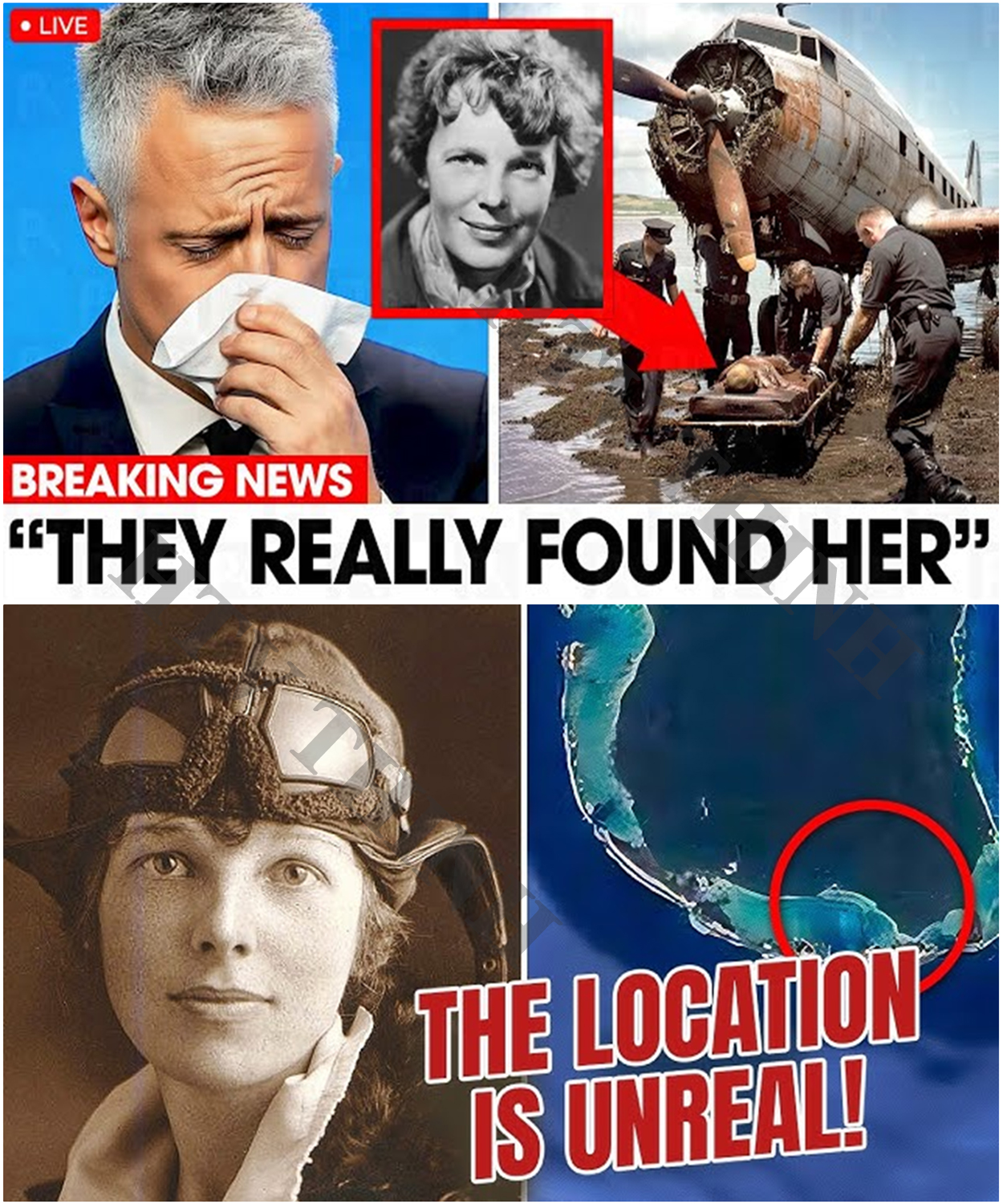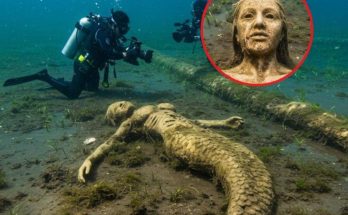Amelia Earhart’s Disappearance: New Clues from a Remote Island Could Rewrite History
For nearly 90 years, the final chapter of Amelia Earhart’s legendary journey has eluded historians, adventurers, and researchers alike. The question of what truly happened to the pioneering aviator and her navigator Fred Noonan has sparked countless theories, expeditions, and debates. But what if the answer wasn’t hidden deep beneath the ocean waves, but rather lying quietly on a remote, overlooked island?
A startling discovery on Nikumaroro Island—formerly known as Gardner Island—is now flipping one of aviation’s oldest puzzles on its head. This remote atoll, located about 400 miles southeast of Howland Island, has long been the focus of the “Nikumaroro Hypothesis,” which suggests Earhart and Noonan may have survived an emergency landing there. Recent satellite imagery revealing what is now called the Taraia Object has added new urgency and potential to this theory.
In this article, we explore the enduring mystery of Earhart’s disappearance, the compelling evidence supporting the Nikumaroro Hypothesis, and why the Taraia Object could finally bring closure to a story that has captivated the world for nearly a century.

Amelia Earhart’s Final Flight: A Disappearance That Defined a Century
Amelia Earhart’s 1937 attempt to circumnavigate the globe was the most ambitious undertaking of her career—a 29,000-mile journey along the equator. Alongside her navigator Fred Noonan, Earhart had successfully completed most legs of the trip, reaching Lae, Papua New Guinea. But the flight from Lae to Howland Island—an isolated speck in the Pacific—would prove fatal.
Despite radio contact with the U.S. Coast Guard cutter Itasca stationed near Howland, Earhart’s Lockheed Electra never arrived. The last known transmission, on the morning of July 2, 1937, stated: “We are on the line 157 337. We are running north and south.” After that, silence.
The U.S. Navy and Coast Guard launched one of the largest search efforts of the era, scouring over 250,000 square miles of ocean. Yet no trace of the Electra, Earhart, or Noonan was found. Officially, the government concluded the plane ran out of fuel and crashed into the ocean. But the absence of debris or distress signals left room for doubt—and many alternative theories.
The Enduring Enigma: Why Has Earhart’s Fate Remained a Mystery?
Over the decades, Earhart’s disappearance has become as much a part of popular folklore as historical inquiry. Theories have ranged from capture by Japanese forces to secret espionage missions, and even to claims that Earhart faked her death. Despite numerous expeditions, sonar scans, and archival investigations, none have conclusively resolved the mystery.
What keeps the story alive is its essential uncertainty. Unlike many historic puzzles, new clues continue to surface, fueling renewed interest and debate. Among the many hypotheses, one location has repeatedly emerged as a compelling focal point: Nikumaroro Island.
The Nikumaroro Hypothesis: Could Earhart Have Survived as a Castaway?
The Nikumaroro Hypothesis suggests that Earhart and Noonan, unable to find Howland Island, veered south and landed on Nikumaroro. The island’s smooth reef flat could have served as a makeshift runway for the Electra, allowing a successful emergency landing.
Evidence supporting this theory includes:
In 1940, a British colonial officer discovered human bones, a woman’s shoe, and a sextant box on Nikumaroro. While initially analyzed as male remains, a 2018 reexamination suggested the bones were “more likely than not” those of a woman matching Earhart’s physical profile.
Additional artifacts such as aluminum fragments, buttons, and U.S.-made glass jars have been recovered, though none definitively linked to Earhart without DNA evidence.
Anecdotal reports of faint radio distress signals shortly after Earhart’s last transmission, which some believe originated from the island.
While no single piece of evidence has conclusively proven the hypothesis, the consistent geographical, archaeological, and historical clues keep it alive.

The Middle Section: The Taraia Object—A Potential Game-Changer in the Search
In 2020, a breakthrough came not from deep-sea sonar scans or government archives, but from a private individual’s observation of satellite imagery. Michael Ashmore, a history enthusiast, spotted a peculiar, cylindrical object in the shallow lagoon near the Taraia Peninsula on Nikumaroro Island.
What Is the Taraia Object?
The object, dubbed the Taraia Object, appears metallic and elongated—bearing a striking resemblance to the fuselage of Earhart’s Lockheed Model 10-E Electra. Satellite images dating back to 2009 consistently show the object in the same location, partially buried in sediment near the lagoon floor.
Dr. Richard Pettigrew, executive director of the Archaeological Legacy Institute (ALI), recognized the potential significance of this find. The Taraia Object lies in an area consistent with the Nikumaroro Hypothesis and could represent the remains of an emergency landing.
Why Was It Missed for So Long?
Traditional search methods—sonar scans, divers, metal detectors—had failed to detect the object due to its location in murky, sediment-rich shallow waters. Only after powerful cyclones in 2015 and 2016 disturbed the lagoon floor did the object become partially exposed, allowing clearer satellite visibility.
This natural uncovering explains why previous expeditions missed the Taraia Object by mere days or weeks. It highlights the role of nature in revealing—or concealing—historical evidence.
Supporting Evidence from Historical Photographs
Adding weight to the Taraia Object’s significance is a little-known 1938 aerial photograph taken by the New Zealand military. The image shows a faint shape in the lagoon near the Taraia Peninsula, matching the object’s location and dimensions.
This early photo predates any organized search and suggests the object has been partially buried and reburied over nearly nine decades. Its longstanding presence argues against it being modern debris.
The Archaeologist Leading the Charge: Dr. Richard Pettigrew’s 2025 Expedition
Dr. Pettigrew brings decades of archaeological expertise and a disciplined, scientific approach to the search. Unlike past efforts that covered vast areas without specific targets, his 2025 expedition focuses narrowly on the Taraia Object.
Using high-resolution satellite data and precise GPS coordinates, Pettigrew’s team plans a careful excavation with minimal environmental disturbance. Techniques include:
Specialized small-scale excavation tools
Remotely Operated Vehicles (ROVs) for underwater documentation
3D photogrammetry to digitally reconstruct the site before any physical removal
Sediment analysis to identify micro-artifacts like rivets or fasteners
This methodical approach aims to confirm if the object’s materials, structural features, and rivet patterns match a 1930s Lockheed Electra.

Why This Discovery Could Finally Solve the Mystery
If the Taraia Object is confirmed as Earhart’s Electra, it would be a historic breakthrough, validating the Nikumaroro Hypothesis and ending decades of speculation.
The implications include:
Clarifying Earhart and Noonan’s final moments and correcting misconceptions about their crash location
Providing insights into early long-distance aviation challenges and navigational errors
Demonstrating the power of interdisciplinary research combining archaeology, satellite imagery, and historical records
Highlighting the role of citizen scientists and open-source tools in solving historical mysteries
Most importantly, it would bring closure to generations fascinated by Earhart’s story, transforming myth into documented fact.
Lessons from Past False Alarms and Why the Taraia Object Stands Apart
Previous promising leads—such as the 2024 Deep Sea Vision sonar discovery—have ended in disappointment. The Deep Sea Vision object, initially thought to be the Electra, was later identified as a natural rock formation.
What sets the Taraia Object apart is:
Over a decade of consistent satellite imagery confirming its presence
Alignment with the Nikumaroro Hypothesis supported by physical artifacts and historical context
Corroboration from a 1938 aerial photograph
A focused, scientifically rigorous expedition led by an experienced archaeologist
This convergence of independent evidence sources makes the Taraia Object a uniquely credible candidate.
Conclusion: Amelia Earhart’s Legacy Beyond the Mystery
Amelia Earhart’s influence extends far beyond her disappearance. As a trailblazing aviator and advocate for gender equality, she shattered barriers and inspired generations.
Her story embodies exploration, ambition, and resilience. Whether she perished at sea, survived briefly as a castaway, or met another fate, the enduring mystery keeps her memory alive.
The search for Earhart’s plane is as much about understanding history as it is about human curiosity and determination. The Taraia Object discovery shows how modern tools, combined with passion and persistence, can illuminate the past.
Whether or not the Taraia Object turns out to be the Electra, Earhart’s legacy reminds us that sometimes the journey—the chase for truth—is as meaningful as the answer itself.



